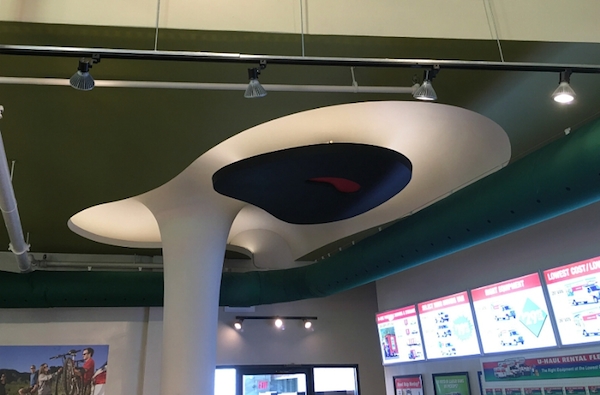
It never ceases to amaze how tastes can change over time. When once-revered artworks are no longer considered beautiful—or valuable—they can be removed, destroyed, covered up, or left to ruin.
In the case of a forgotten Isamu Noguchi work, it was that questionable architectural feature, the drop ceiling, that was hiding a custom designed Noguchi work at the former The American Stove Company-Magic Chef building in St. Louis, now serving as a showroom for moving and storage company U-Haul.
“We’re so pleased to be able to share this artwork with the community again,” said president of U-Haul Company of St. Louis, Steve Langford, in a statement announcing the restoration of the unique piece.
The building’s architect Harris Armstrong commissioned the lobby ceiling from Noguchi when the structure was finished in 1946. U-Haul acquired the building in 1977 but renovations on the ceiling didn’t start until two years ago, when the company decided to refurbish and extend their showroom.
“In conjunction with improving the showroom, my intention was to reveal the ceiling,” Langford explained. “There was a Noguchi exhibit at the St. Louis Art Museum running around the time we began working on this project, so there were lots of photos to use as a frame of reference.”
The Noguchi ceiling, hidden from view for decades, has been repaired and painted according to its original look and colors. Not only is the work a welcome addition to the artistic landscape of St. Louis, it is also significant in the context of Noguchi’s oeuvre.
“Isamu Noguchi’s sculpted ceiling designed for the 1946 Magic Chef building in St. Louis is the last surviving of the seminal American artist’s monumental ‘lunar landscapes,'” Genevieve Cortinovis, assistant curator of decorative arts and design at the St. Louis Art Museum explained in the statement released by U-Haul.
“Visually striking and fundamentally practical, the plaster ceiling’s undulating curves, characteristic of Noguchi’s biomorphic sculpture of the 1940s, provided discreet signage, lighting, and a welcome burst of color for visitors of the International Style building by architect Harris Armstrong,” she eulogized.
“Noguchi held that by lending punctuation and dimension to space, these large-scale sculptures, an extension of the architecture itself, could make people ‘feel better, feel happier to be there.'”
The sculptured ceiling is indeed a thing of wonder and U-Haul are welcoming the public in St. Louis to come in and admire it.